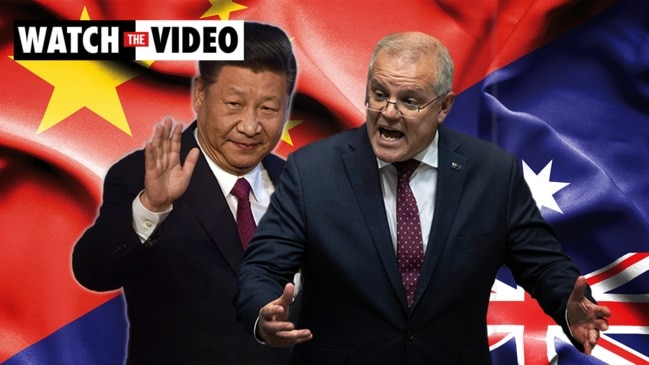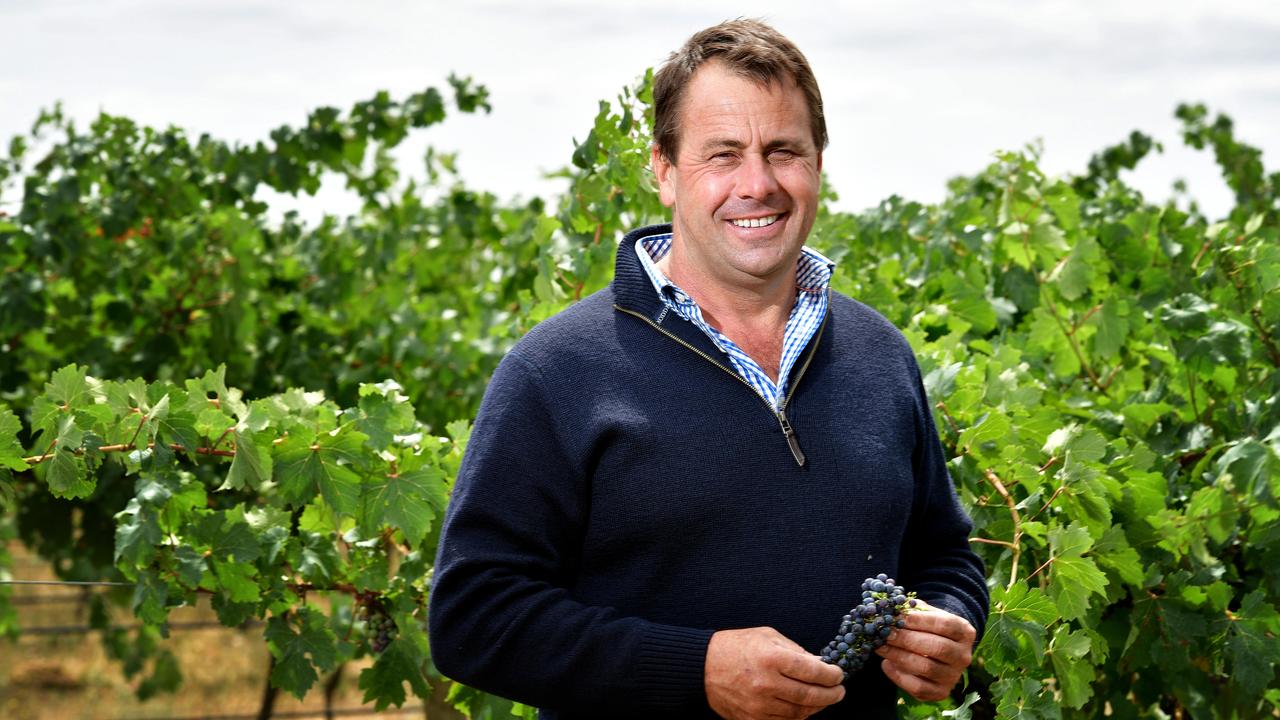China blocks Australian bulk wine imports worth $50m
China has imposed a fresh boycott on Australian wine, blocking even those imports not subject to punishing tariffs.

Australian bulk wine exports worth more than $50m annually are being barred from China despite being exempt from punishing tariffs on the bottled product.
Warren Randall, owner of Seppelstfield, the world’s leading exporter of luxury-grade bulk wine to China, revealed his business alone has lost more than $15m since the communist regime last month barred the product.
Of the $50m worth of bulk wine exports to China last year, $39m was from South Australia, according to official figures from Wine Australia.
Bulk wine is exported in 24,000-litre bladders. Chinese brands then bottle it under homegrown labels, which sell for about $400 a bottle for top-grade wine from the Barossa Valley and McLaren Vale.
Bottled wine imports were hit with tariffs of up to 212 per cent in November, but bulk products were excluded.

Mr Randall said five containers of bulk wine had successfully been imported through Shandong province ports in December, after the tariff imposition.
“But some time in January, the Chinese central government came out and said that no Australian wine will be cleared from Australian ports – so it doesn’t matter whether there’s a tariff on bulk or not,” Mr Randall said. “This is not a knockout blow but it does make you stagger around the ring.”
Mr Randall said his firm was contacting Chinese importers one to twice a week and being told they wanted Australian wine but were not willing to take any risks.
“It’s not as if the Chinese don’t want our wine – that’s not the case. They definitely want Australian wine,” he said.
“They definitely want Seppeltsfield wine … bulk wine from the Barossa and McLaren Vale.

“But they’re concerned about the consequences of importing Australian wine because the central government has categorically stated that no Australian wine will be cleared from Chinese ports.”
Mr Randall said one container of Seppeltsfield tawny port had been caught on Chinese docks in January but eventually let through. Since then, the business had been searching for other markets.
Chinese wine tariffs have cost the industry about $1.3bn, equivalent to 23 per cent of the Australian crop. This equates to about 170,000 tonnes of the national crop – about 10 per cent.
Mr Randall said producers were hoping for a post-Brexit free-trade deal with the UK.
But supermarkets dominated its market and Australian wine sold there was one-third the value of to China.

THE HANGOVER BEGINS...
McLaren Vale must find another home for $42m worth of bottled wine usually destined for China.
Jennifer Lynch, who manages the region’s wine and tourism association, says no other single market could replace China’s once-thriving demand.
Hit by tariffs of up to 212 per cent, winemakers are focusing on increasing sales on the domestic front and other global markets.
The introduction of tariffs in November saw exports to China drop by 36 per cent to $27m. Chinese consumers have a thirst for quality Australian wine, the bulk of which – until that point – came from South Australia.
“So many of our export markets are in a state of flux that we’re yet to fully understand how the distribution and export mix will change,” Ms Lynch said.
Gemtree Wines managing director Mike Brown said China had accounted for about 20 per cent of the company’s business. Mr Brown said he had now directed more energy into direct-to-consumer sales, along with expanding partnerships in the UK.
“There’s also new opportunities out there, without a doubt. Korea is an example and Taiwan,” Mr Brown said.
In a cautionary warning, Mr Brown expects the full impacts of the tariffs will be felt further down the track.
“Potentially, we’re going to see a shrinking of producers and quantity of wine being made,” he said.
“If we haven’t found a replacement market at the end of 12 months and going into the next 24 months, then I think you’re going to see more pain in the industry.
“Probably the grower is going to be the person that’s hit the most. They’re at the end of the food chain and they’ll be the first people that businesses let go.”

CLARE VALLEY
Taylors Wines managing director Mitchell Taylor says China had accounted for up to 15 per cent of the Clare Valley’s exports.
Mr Taylor, a board member of Wine Australia, said adding to the concern was that a four-year $50m support package to help market Australian wine overseas was due to expire mid-year.
He said extending federal funding was vital during the sector’s hour of need – especially at a time when levies paid to Wine Australia from company exports were also dropping.
About 20 per cent of Taylors’ exports are usually China-bound. Mr Taylor said they had been forced to offload containers from a ship in Singapore when the market suddenly closed.
The company also retrenched a staff member as a result of the tariffs.
“If we don’t get good future growth coming through, through industry support … it will start to have an effect on regional employment,” Mr Taylor said.
Improving trade partnerships with the US, Canada, Hong Kong, the UK, Japan and other parts of Asia are top of the agenda, but that, too, has come with its own challenges amid international travel bans and social distancing restrictions.
Mr Taylor’s brother and winery general manager, Clinton, said the tariffs had come as a shock.
“After years of working to grow our Clare Valley wines in that market, it’s like the rug was swept out from under our feet,” he said.
“It’s important to us that the Australian Government assists the industry in reaching out to new and existing markets by giving us the tools and resources to promote and grow the premium profile of Australian wine,” he said.

ADELAIDE HILLS
Adelaide Hills Wine Region president Jared Stringer says it’s been spared the tariffs’ immediate impacts. But he’s still worried about potential flow-on effects, including wine usually destined for China flooding the domestic market, pushing down prices.
“There certainly isn’t going to be a silver bullet here,” said Mr Stringer, also chief executive at The Lane Vineyard.
“All of that supply has to go somewhere. It’s not going to go to China, certainly, and the US isn’t capable of taking it all and neither is the UK.”
Both of those markets were reeling from the effects of the pandemic, which had shut down pubs, clubs and restaurants.
“If there’s an oversupply, it means that retailers will go, ‘OK, well I can probably sell what was a $50 Barossa shiraz for $30 so I don’t need to take an Adelaide Hills shiraz,” Mr Stringer said.
“Growers will potentially either see their grape prices slashed or will struggle to sell them.”
BAROSSA VALLEY
More than $130m worth of Barossa Valley wine was set go to China in 2019, presenting it with a huge uphill battle to plug the gap.
While the tariffs only came into force in November, last year’s bottled wine exports sent to China still dipped by more than $30m.
Langmeil Winery chief executive Matthew McCulloch says much of his China-bound has been diverted into the Australian market and the company’s wine club.
“We’ve invested in 15 years of building relationships with our Chinese partners and we’re just hoping this is temporary,” Mr McCulloch said.
“Most of our red wines from the 2021 vintage wouldn’t be released until 2022 and the premiums until 2023. You would have to hope with the vaccination and hopefully a repair of the relationship between Australia and China that things would return to normal.”
About 15 per cent of Langmeil’s exports usually went to China, but other businesses with a higher reliance on the country would be hit much harder, Mr McCulloch said.
“They’ll be thinking about not buying fruit or laying off staff,” he said.
“I’ve have certainly had growers approach asking if we’d like more fruit than we’d normally take from them.
“It’s either become available because contracts have been capped or people are reducing their intake.”
Barossa Grape and Wine Association chief executive James March said the organisation was supporting members to explore other markets, and providing e-commerce help.

COONAWARRA
Resurging allegiance to local producers is helping Coonwararra wineries weather the brunt of the turmoil, says Pete Balnaves, president of the region’s vignerons’ association.
“There seems to be a strong commitment from Australian citizens to refocus on Australian products, be it clothes, wine or luxury items,” he said.
“We’re taking a positive out of the negative with the pandemic.”
Online domestic sales have boomed, and Mr Balnaves, of Balnaves of Coonawarra, said continued support from Australians was top of his wishlist to help cope with the China trade barrier.
Vintage is under way and with yields likely to be above the long-term average, this will also help reduce the burden of any price reduction. Local producers are looking to direct more wine to other markets including the US, UK and India.
RIVERLAND
Riverland Wine general manager Jo Pippos says the area hasn’t been as badly affected by the tariffs as premium regions such as the Barossa.
“We’ve been largely unaffected compared to the cool-climate regions,” she said.
“Vintage is looking pretty strong and our vines are very healthy and very heavy so it’s made a positive of what could be a bad situation.”
Trade Minister Stephen Patterson said the State Government was helping the industry work through issues.
“I’ve been visiting SA’s wine regions, holding roundtable and meeting with industry representatives and businesses to ensure the government’s response is what they require,” he said.
Mr Patterson said the government was working with industry on a “suite of programs” to grow sales in new and existing markets.
Originally published as China blocks Australian bulk wine imports worth $50m




